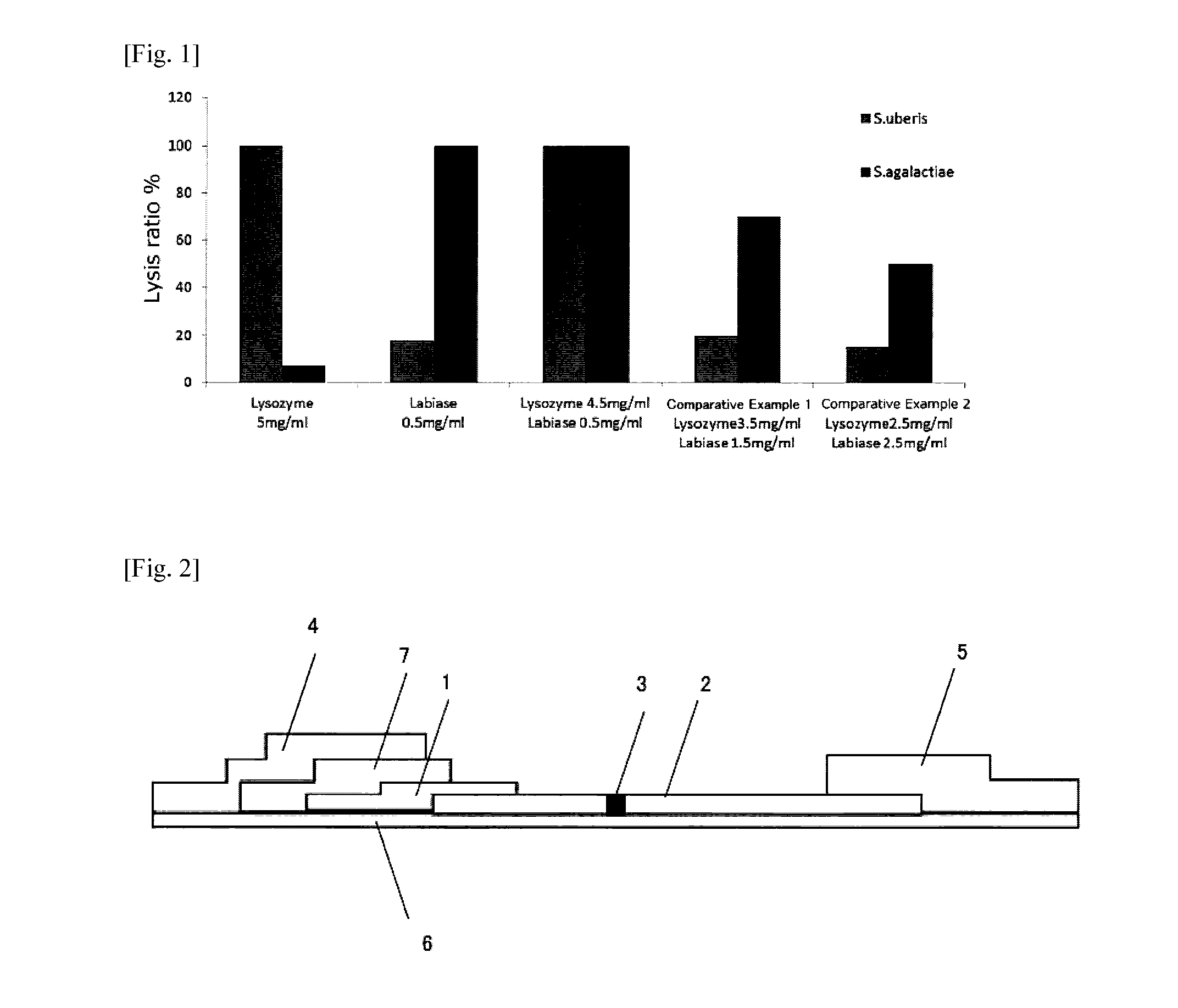Method for detecting streptococcus bacterium contained in milk
a technology of streptococcus and detection method, which is applied in the field of lysis method and detection method for detecting a streptococcus bacterium, can solve the problems of insufficient lysis in many cases, several days to obtain, etc., and achieve the effect of high efficiency and high efficiency lysed
- Summary
- Abstract
- Description
- Claims
- Application Information
AI Technical Summary
Benefits of technology
Problems solved by technology
Method used
Image
Examples
example 1
(1) Preparation of Ribosomal Protein L7 / L12 Antibody
[0091]According to the method described in the examples of International Patent Publication WO00 / 06603, the L7 / L12 ribosomal protein was obtained, and monoclonal antibodies were prepared by using this protein. Among the monoclonal antibodies, a combination of two kinds of monoclonal antibodies that can simultaneously bind to different sites of the aforementioned L7 / L12 ribosomal protein was selected.
(2) Evaluation of Lytic Activity by ELISA
[0092]S. uberis or S. agalactiae cell count was adjusted to 1×109 (cells / ml) with physiological saline to prepare a cell suspension. Further, 6 kinds of the enzymes shown in Table 1 were each diluted with a 1:1 (v / v) mixture of milk and each buffer to a concentration of 1 mg / ml or 10 mg / ml to prepare enzyme solutions.
TABLE 1Concentration of enzymesolution (final concen-Manufac-tration after mixingLytic enzymeturerBufferwith cell suspension)Labiase (Lot,OzekiCitrate / 1 mg / mlBDBAC12)*1phosphate(0.5 ...
example 2
[0098]The bacteria were treated in the same manner as described above with labiase and lysozyme at final concentrations of 0.5 mg / ml and 4.5 mg / ml, respectively, adjusted with a mixture of a citrate-phosphate Na buffer and milk (mixing ratio in volume was 1:1). The results for lysis ratio calculated from the results of ELISA are shown in FIG. 1. It was revealed that when lysozyme or labiase was used alone, the bacteriolytic activity was insufficient for either the bacterium S. uberis or S. agalactiae, but if they are used in combination as a mixture in certain concentration ranges thereof, both the bacteria can be highly efficiently lysed.
example 3
Preparation of Immunochromatographic Device
[0099]An immunochromatographic device was prepared as follows.
(a) Gold Colloid-Labeled Antibody-Impregnated Member
[0100]A gold colloid solution (particle size 60 nm, 0.9 mL, BB International) was mixed with 0.1 M potassium phosphate, pH 7.0, a monoclonal antibody 1 (100 μg / mL) to be labeled with gold colloid was added to the mixture, and the resulting mixture was left standing at room temperature for 10 minutes so that the antibody bound to the gold colloid particle surfaces. Then, a 10% aqueous solution of bovine serum albumin (BSA) was added at a final concentration of 1% in the gold colloid solution, so that the remaining surfaces of the gold colloid particles were blocked with BSA, to prepare a solution of the monoclonal antibody 1 labeled with gold colloid (henceforth referred to as “gold colloid-labeled antibody”). This solution was centrifuged (at 15000 rpm for 5 minutes) to precipitate the gold colloid-labeled antibody, and the supe...
PUM
| Property | Measurement | Unit |
|---|---|---|
| concentration | aaaaa | aaaaa |
| concentration | aaaaa | aaaaa |
| concentration | aaaaa | aaaaa |
Abstract
Description
Claims
Application Information
 Login to View More
Login to View More - R&D
- Intellectual Property
- Life Sciences
- Materials
- Tech Scout
- Unparalleled Data Quality
- Higher Quality Content
- 60% Fewer Hallucinations
Browse by: Latest US Patents, China's latest patents, Technical Efficacy Thesaurus, Application Domain, Technology Topic, Popular Technical Reports.
© 2025 PatSnap. All rights reserved.Legal|Privacy policy|Modern Slavery Act Transparency Statement|Sitemap|About US| Contact US: help@patsnap.com

